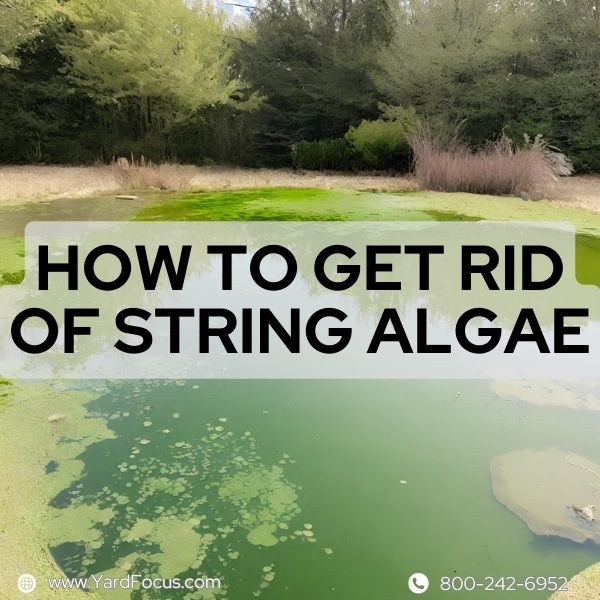
How To Get Rid Of String Algae
Do you need to learn how to get rid of string algae? String algae can indicate a healthy ecosystem in moderation, yet excessive growth signals imbalances needing attention.
This blog will guide you through effective ways to clear out the nuisance and maintain a beautiful water garden.
Keep reading, your clear pond awaits.
Understanding String Algae
String algae cling to rocks, plants, and decorations in your pond.
You might see thick mats of this green stuff waving in the water. It is also known as filamentous algae because it forms long threads that can feel slimy.

These strands start tiny but can grow very long when they have enough light and nutrients.
This kind of algae uses sunlight to make food through a process called photosynthesis.
The more sunlight and nutrients available, like from fish waste or decaying leaves, the faster it grows.
It thrives in waters with high nutrient levels, often resulting from runoff carrying fertilizers from nearby lawns into your pond.
String algae are part of a natural cycle in ponds but can become too much if conditions are just right for them to multiply quickly.
Causes of String Algae in Ponds
Sunlight shines on ponds for many hours, which can make string algae grow fast. Nutrients in the water feed the algae.
Nutrient sources include fish waste, decaying vegetation, and external runoff, each contributing to algae growth.
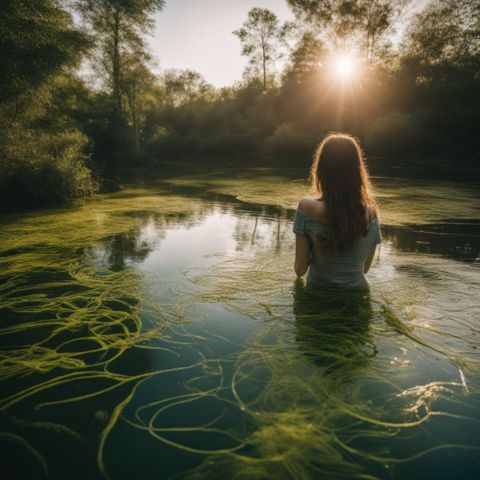
Ponds with too many fish can have more waste, and this makes even more food for string algae.
If pond water does not move much, it helps string algae to spread. Stagnant water lets sunlight reach all parts of the pond evenly.
Too much light and still water are like a feast for string algae.
Pumps and filters need to work right to keep water clean. If they break or get clogged, they stop cleaning the water well enough.
This means nutrients build up easier and help algae grow.
Using lots of fertilizer near ponds can also cause trouble; rain washes it into the pond which feeds the algae even more.
Leaching from nearby gardens adds unwanted chemicals that help string algae thrive.
Having good bacteria in your pond is important because they eat up nutrients that could feed string algae otherwise.
Sometimes there just aren’t enough of these helpful little cleaners around.
Is String Algae Harmful?
While not directly toxic, excessive string algae growth can indirectly harm aquatic life by degrading water quality and oxygen levels.
However, it can overtake a pond and become an eyesore. Thick mats of string algae block sunlight and reduce oxygen levels in water.

This makes it hard for fish and plants to thrive.
Too much string algae may also mess with the nitrogen cycle of a pond. It uses up nutrients that other aquatic plants need to grow.
When string algae dies and decomposes, it can decrease water quality by consuming oxygen needed by fish and other aquatic life.
This can harm fish health if not controlled on time.
So, while it's not toxic itself, its effects can cause trouble for your backyard pond or water garden if left unchecked.
Steps to Eliminate String Algae
Getting rid of string algae is a multi-step process that targets both the symptoms and sources of this aquatic nuisance.
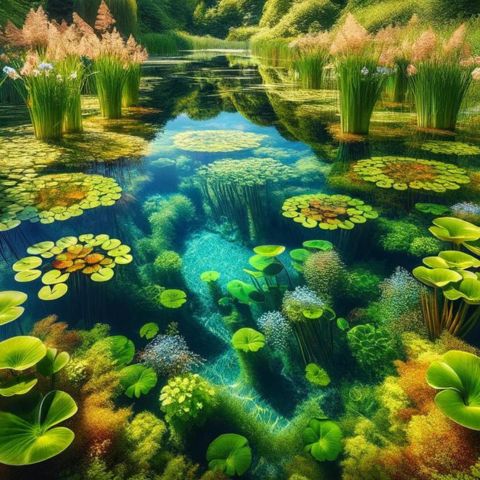
By implementing strategic measures, you can restore the balance of your pond's ecosystem, paving the way for clear and healthy waters.
Physically Extracting String Algae
String algae can overtake a pond quickly, but removing it by hand is a great first step.
This method is direct and effective in clearing out the invasive growth. Here's how to get started:
- Wear gloves to protect your hands before you begin pulling out the algae.
- Gently pull at the string algae clumps, taking care not to harm any pond life.
- Use a rake or a long stick to reach deeper into the pond if necessary.
- Place the extracted algae into a bucket or on land to dry out.
- Check around rocks, plants, and decorations as string algae often hide there.
- After removal, leave the algae on the shore for a day so that any small creatures can make their way back into the water.
- Dispose of dried string algae away from the pond to prevent it from reentering.
- Clear out debris regularly as decomposing organic matter feeds new algae growth.
Identifying the Underlying Cause
To get rid of string algae, you must find out what's feeding it. Check your pond's pH levels and test for high phosphorus content.
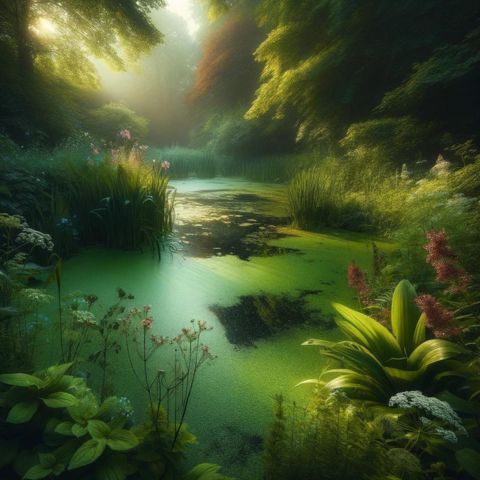
Often, too much fish food or plant debris plays a big part in the growth of nuisance algae.
Excess nutrients create an ideal playground for string algae to thrive.
Look over your water garden carefully. Make sure your filtration system is up to par; poor filters can’t keep up with the bio load from fish waste and leaves.
Too little beneficial bacteria adds to the problem as well.
Keep these factors in check to prevent future blooms of unwanted algae in your koi pond or water garden.
Treating Water to Kill Off Remaining Algae
Once you have pinpointed what's causing string algae in your pond, it's time to take action against any leftovers.
Use water treatments that target algae without harming fish or plants.
Start with a safe algaecide following the recommended dosage on the label. This will help get rid of remaining string algae.
You can also introduce natural options like beneficial bacteria to your pond maintenance routine.
These good microbes compete with algae for nutrients, helping keep growth in check.
Don’t forget about keeping oxygen levels up!
An aerator boosts these levels and supports healthy water gardens by aiding bacteria in breaking down organic matter—less food for algae means less algae growth!
Adding Extra Aquatic Plants
After dealing with the remaining algae, bring in aquatic plants to keep it away.
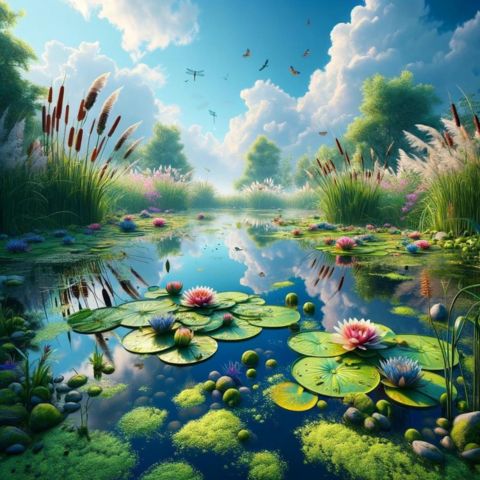
Plants like Water Lettuce, Cattails, and Irises are great for this. They not only grab up nutrients that algae need but also give shade and more oxygen to the water.
This helps your pond stay clear.
Get some Water Hawthorne too, because it works even in cooler seasons. These plants make a home for snails that love eating string algae.
With more plants in your goldfish pond or any pond, you create a better balance against pesky algae like pond scum and help cut down on future fish kills caused by bad water conditions.
Reducing Fish Feed
Adding extra aquatic plants is a smart move, but there's more you can do.
Cut back on feeding your fish too much. Overfeeding leads to leftover food in the water, which feeds string algae.
Give your fish only as much food as they can eat in a few minutes.
Too many nutrients from excess feed make algae grow fast. By feeding fish less, you reduce these nutrients.
This simple step helps control algae without harming your pond life. Keep an eye on how much you feed and adjust it to keep algae away for good!
Chemical Methods for Algae Removal
For algae control, prioritize environmentally safe treatments, carefully assessing their compatibility with your pond's unique ecosystem and ensuring they do not harm aquatic life.
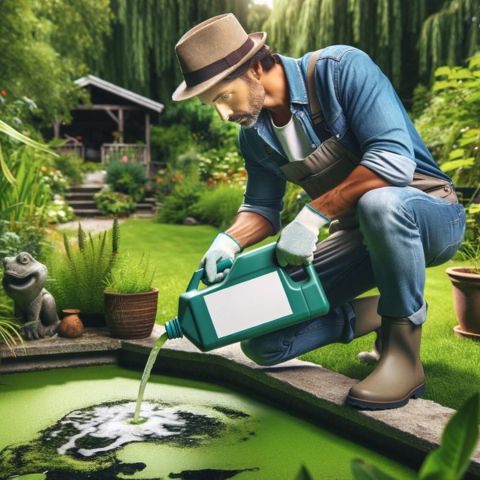
Choose treatments that release oxygen to break down algae quickly, ensuring they are designed to be harmless to your pond's aquatic life.
Apply selected treatments according to guidelines, focusing on areas with significant algae growth, and monitor effects carefully.
Applying barley straw extract, an eco-friendly method, can help manage algae growth, although results may vary and consistent, long-term application is necessary for effectiveness.
As it breaks down in water, it slowly forms hydrogen peroxide which stops new algae from growing.
For serious problems, try an ionizer which sends copper ions into the water to get rid of string algae without damaging plants or fish.
Natural Methods for Algae Control
Embracing natural methods for algae control not only preserves the delicate balance of your pond's ecosystem but can also offer a sustainable, long-term solution to string algae issues.
Learn how leveraging nature's own mechanisms can keep your waters clear and healthy without resorting to harsh chemicals.
Introducing Beneficial Bacteria
Beneficial bacteria are your pond's unseen heroes. They help get rid of string algae by eating the same nutrients algae need to grow.
Add these bacteria as water treatments or additives, and watch them work their magic.
These tiny workers help break down organic matter, cutting down on what feeds algae.
Using beneficial bacteria is a smart move for your pond's health. Not only do they tackle string algae, but they also make your water clearer and less smelly.
When paired with other natural methods like adding plants or reducing fish food, these friendly microbes play a big role in keeping your ecosystem balanced and thriving.
Using Barley Straw Extract
Barley straw extract is a natural fighter against string algae. It's eco-friendly and works without harming fish or plants in the pond. However, its effectiveness can vary, and consistent results might require long-term application and optimal conditions.

Pour the liquid into your water, and it starts to battle algae.
Be patient though; it takes about 6-8 weeks to see clear changes.
Keep using barley straw extract regularly for best results. This method helps prevent new algae from growing too fast.
It’s an easy step towards a cleaner pond and healthier aquatic life.
Installing an IonGen System
Choose a spot in your pond to install the IonGen System. Make sure it's easy to reach for maintenance.
Follow the manufacturer's instructions carefully. You'll connect the system's control panel to a power source and attach the probe into your pond water.
Keep an eye on the IonGen System after you set it up. Check it regularly to make sure that it’s working right and controlling algae growth effectively.
Use this method along with adding beneficial bacteria for more natural algae control in your pond.
Increasing Oxygen Levels in the Pond
After setting up an IonGen system, focus on boosting oxygen in your pond.
Installing aeration devices such as air pumps and diffusers is highly beneficial, as they circulate water and significantly increase oxygen levels, promoting a healthier pond environment.
This makes life better for fish and plants.
You can also put in a waterfall or fountain. These look great and mix air with water, which adds more oxygen.
Exercise caution with liquid algaecides in fish-populated ponds, as some formulations might reduce oxygen levels. Always select products certified as safe for use around aquatic life.
Instead, boost those oxygen levels to keep algae under control!
The Role of Filtration in Controlling String Algae

Filters play a big part in fighting string algae. They remove tiny particles from the water. This makes it hard for algae to grow. Mechanical filters catch debris that can feed the algae.
Biological filters use good bacteria to break down waste products. These waste products could otherwise help algae thrive.
Good filtration keeps water moving and clean. Moving water has more oxygen, which helps fish and plants but is tough on algae.
Make sure your filter fits your pond size. Clean it regularly to keep it working well against string algae growth.
Treatments to Avoid for String Algae Removal
While proper filtration is a key player in managing string algae, some treatments might do more harm than good.
It’s important to steer clear of the following methods:
- Avoid adding copper - based algaecides to your pond. These can be toxic to fish and beneficial pond organisms.
- Stay away from using bleach or other harsh chemicals. They can kill plants and wildlife in and around your pond.
- Don’t overuse UV sterilizers. While they can control algae, they also may destroy beneficial bacteria needed for a healthy ecosystem.
- Skip homemade remedies like baking soda or vinegar. These can disrupt the pH balance of the pond water.
- Do not remove all algae at once; it can shock the ecosystem. Gradually reduce it over time.
- Keep away from excessive manual removal without addressing the cause. This can lead to more algae growth.
- Resist the urge to constantly change water as it can stress pond life and doesn't get to the root problem.
- Be cautious about introducing fish that eat algae without researching their specific needs and impact on the pond. Some fish could overpopulate or become invasive.
FAQs
What are string algae?
String algae are long, hair-like plants that can be green or blue-green and often grow in ponds or aquariums.
Why should I remove string algae from my pond?
It's a good idea to get rid of string algae because they can take over your pond and make it hard for other plants and animals to live there.
Can I prevent string algae from growing in the first place?
Yes, you can stop string algae from growing by keeping your water clean and balanced, not overfeeding fish, and using plants that compete with algae for nutrients.
What's a natural way to get rid of blue-green string algae?
If you have blue-green string algae, try adding more plants to use up the nutrients or use barley straw as it slowly breaks down and stops the growth of new algae.
Conclusion
When beginning to learn how to get rid of string algae, start with removing it by hand. Find what's feeding the algae and fix that problem.
Use both chemical and natural solutions to keep algae away. Remember, adding plants helps a lot since they eat up nutrients that algae need.
Keep your pond clean, your fish happy, and enjoy clear water!
